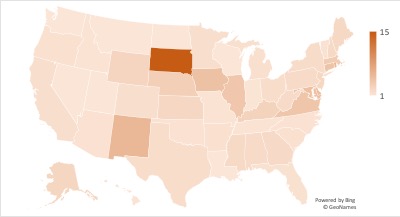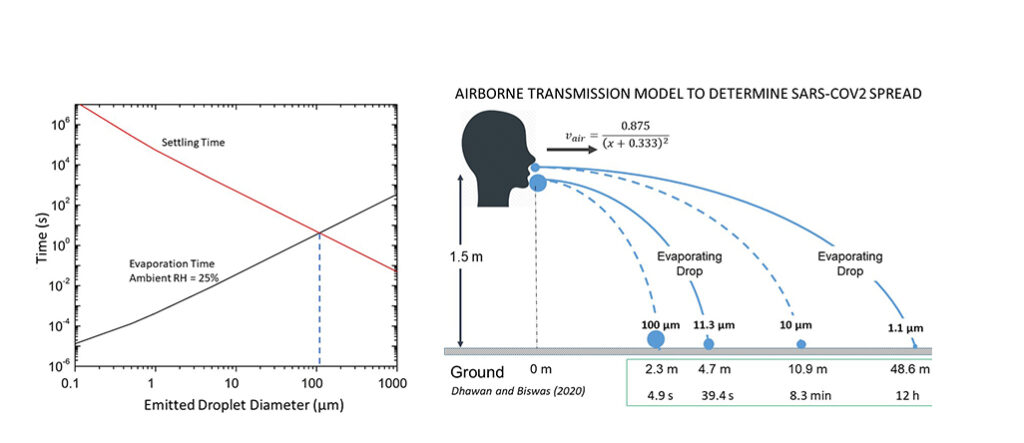
Researchers at the McKelvey School of Engineering at Washington University in St. Louis are at the forefront of aerosol science. With ongoing research from as high as 250 miles above earth at the International Space Station, down to remote marine environments, the Center of Aerosol Science and Engineering (CASE) has expertise from the broadest scale to the molecular level.
Right now, that's the kind of range in expertise needed to tackle COVID-19, the disease caused by the SARS-Cov-2 virus. McKelvey experts are putting their expertise to work.
Researchers are taking the 30,000-foot view and zooming in to the molecular level. And they're also investigating the domain in between - on the ground where the virus is affecting all of us.
Here is a look at some of the groundbreaking work - happening at groundbreaking speed - being carried out by faculty and researchers at CASE:
30,000-foot view:
Jian Wang, CASE director; professor of energy, environmental and chemical engineering
Wang and members of his lab are studying the impact of business disruption due to COVID-19 on the atmospheric aerosol population.
"We are looking at the measurements at a surface station in the Azores, which is thousands of kilometers 'downwind' of North America," he said. "We are interested in finding out if the 'shutdown' leads to a decrease of aerosol concentration in remote marine environments and the effects of aerosol on marine clouds."
Randall Martin, professor of energy, environmental and chemical engineering
Martin and his group are applying satellite remote sensing to assess how air pollution is changing around the world in response to COVID-19. He also is collaborating with colleagues to understand how air pollution affects COVID-19 mortality rates.
Data from his group were included in a national study published April 5 by Harvard University on long-term exposure to air pollution and COVID-19 mortality in the United States.
The study, featured in The New York Times, found that an increase of only 1 microgram per cubic meter in PM2.5 - fine particulate matter that can embed in the respiratory tract - is associated with a 15% increase in the COVID-19 death rate.
Jay Turner, vice dean for education; professor of energy, environmental and chemical engineering
Turner and his team have been conducting long-term air quality measurements in a Louisville, Kentucky, neighborhood and will continue these measurements and the corresponding sample analyses in the lab during the COVID-19 pandemic. They will analyze data to determine if there have been changes to air quality and exposures.
"We collect two-week samples once every two months, having been doing so for about 18 months," Turner said. "The measurements are for our NIH-funded study on the effects of greenness on cardiovascular health. Like many environmental research projects, we just happen to be in the field at this time and can track impacts of COVID-19 on environmental burdens."
On the ground:
Pratim Biswas, assistant vice chancellor; chair of the Department of Energy, Environmental & Chemical Engineering; the Lucy & Stanley Lopata Professor; and head of the Aerosol and Air Quality Research Laboratory (AAQRL)
Researchers in the university's Aerosol and Air Quality Research Laboratory are working with physicians Stephen Y. Liang, MD, assistant professor of medicine, and Laura Marks, MD, PhD, a fourth-year fellow, both in the Division of Infectious Diseases at the School of Medicine. Liang and Marks are on the frontline with COVID-19 patients and are deploying IOT-enabled sensors to monitor airborne concentrations, providing health care workers with a quick overview of conditions in patient observing rooms.
Biswas also has a patented air cleaning technology: a photoionizer-based electrostatic precipitator, which not only removes particles with very high efficiency, but has been proved to completely inactivate bioagents, including a range of viruses. This would be ideal to use in ventilated, indoor environments.
Rajan Chakrabarty, assistant professor of energy, environmental and chemical engineering
Chakrabarty has used computer modeling to determine how social distancing relates to health care demand, both hospital beds and ICU beds based on different scenarios.
Assuming the United States does not plan on implementing social distancing forever, he said, "One thing we have found out based on our data sets is that you really have to be careful not to extend intermittent social distancing through a longer period than a 5-to-1 distancing/no-distancing period. Beyond this ratio, the benefit of social distancing diminishes to a negligible level."
His model, which is unique in its inclusion of age stratification, also forecasts the epidemic's evolution over time based on:
- the estimated number of unreported active COVID-19 cases
- length of time of school and business closures
- length of time that the elderly practice social distancing

Zooming in:
Brent Williams, the Raymond R. Tucker Distinguished InCEES Career Development Associate Professor
Williams is guiding one of two groups researching how well face masks can filter out particles, such as viruses and small droplets. Research teams are investigating low-tech solutions for the public; different materials for masks that compare to the highly efficient N95 masks; and the stability and performance of those N95 masks with extended use. They are collaborating with the School of Medicine and the Sam Fox School of Design & Visual Arts on mask design and fit.

"We are looking at what fraction of particles are removed by these materials/masks at different particle sizes and different air flow rates," he said. "Large and small particles are collected on the masks by different physical mechanisms, so the collection performance can be different for different size particles."
Biswas
AAQRL researchers are working to better understand the infectivity of SARS-CoV-2 and aerosolization of antiviral agents (studies on self-assembly and denaturing). This important fundamental study will aid in the development of aerosol delivery methodologies for antiviral drugs and targeting them at the appropriate location to be effective. The work is being done by Hao Zhaou, a PhD student, under Biswas' guidance.
Airborne Transmission of SARS-CoV-2 Viruses: Detailed models accounting for aerosol dynamics are developed and used to get an accurate estimation of the lifetime of airborne viruses. Sukrant Dhawan, a doctoral student, and Biswas are working on this important problem.
AAQRL is also home to a test facility determining size dependent removal of filters. It is important to understand the efficiency of alternative materials for masks that can be used by the public, so researchers are testing a variety of commercial and homemade face masks. The work is led by PhD students David Dhanraj, Shruti Choudhary and Ben Kumfer. Biswas is guiding the research.

Richard Axelbaum, the Stifel & Quinette Jens Professor of Environmental Engineering Science
Axelbaum is also working to identify options to address the shortage of N95 respirator masks available to health care workers.
He is taking into account factors such as filter material and fit, but also relevant science concepts, such as fluid dynamics - which is important because the forces that drive the movement of air (breath) when we inhale differs from those at work when we exhale. As such, the requirements for face masks differ depending on, among other things, whether we are trying to protect the wearer or protect others from the wearer.
WashU Response to COVID-19
Visit coronavirus.wustl.edu for the latest information about WashU updates and policies. See all stories related to COVID-19.






